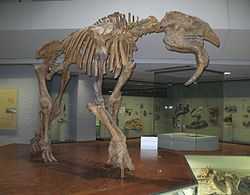Prodeinotherium
| Prodeinotherium Temporal range: Early Miocene–Mid Miocene | |
|---|---|
 | |
| Prodeinotherium bavaricum | |
| Scientific classification | |
| Kingdom: | Animalia |
| Phylum: | Chordata |
| Class: | Mammalia |
| Order: | Proboscidea |
| Suborder: | †Deinotheroidea |
| Family: | †Deinotheriidae |
| Subfamily: | †Deinotheriinae |
| Genus: | †Prodeinotherium Ehik, 1930 |
| Species | |
| Synonyms | |
| |
Prodeinotherium (pro - "before" "terrible beast") is an early representative of the family Deinotheriidae, that lived in Africa, Europe, and Asia in the early and middle Miocene.[1]
Description
Prodeinotherium was the size of the present Asian elephant, about 9 feet at the shoulders, but differed from elephants in possessing a pair of downward curving tusks on the lower jaw.
In appearance and many characters it was like Deinotherium (with which it is placed in the subfamily, Deinotheriinae (Sanders et al. 2004), but differed in being of smaller size, having shorter forelimbs, and also in various details in the shape and form of the teeth. [2]
The earliest species to appear is Prodeinotherium hobleyi, known from the Early Miocene of Kenya, Namibia and South Africa [1] (about 18 to 20 million years old). Fossils of Prodeinotherium hobleyi were also found in Jebel Zelten in Libya.[3] A molar of a small prodeinothere from Eritrea may also belong to this species and be of the same age.
Prodeinotherium hobleyi was larger and more specialised than its Oligocene predecessor Chilgatherium. It flourished for several millions of years, before being suddenly replaced in the middle Miocene by the much larger Deinotherium.[2]
References
- ↑ 1.0 1.1 1.2 Paleobiology Database
- ↑ 2.0 2.1 Sanders, W. J., Kappelman, J. & Rasmussen, D. T., 2004 New large-bodied mammals from the late Oligocene site of Chilga, Ethiopia. Acta Palaeontologica Polonica Vol. 49, no.3, pp. 365–392
- ↑ Natural History Museum of Crete
- John M. Harris (1978) Deinotherioidea and Barytherioidea. 315-332, in Maglio, V. J. & Cooke, H. B. S., (eds.) 1978: Evolution of African mammals, Harvard University Press, Cambridge & London
- Sanders, W.J., 2003, chap 10, Proboscidea, in Mikael Fortelius (ed) Geology and paleontology of the Miocene Sinap Formation, Turkey, Columbia University Press, New York
- Reconstruction of Prodeinotherium